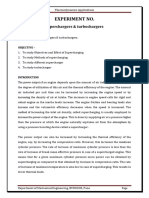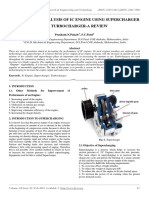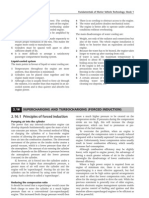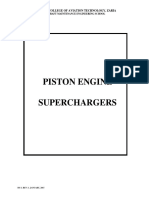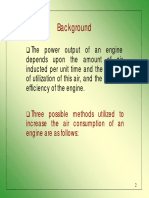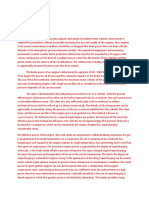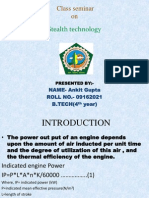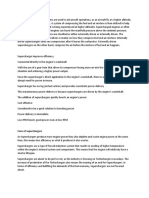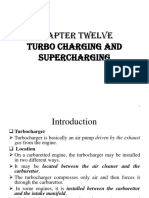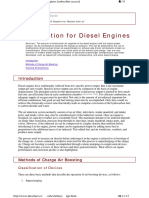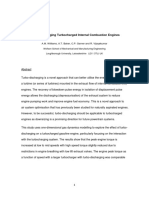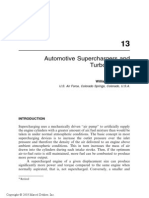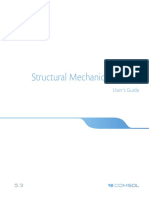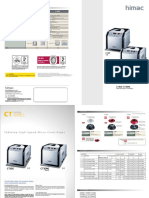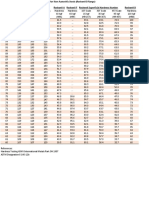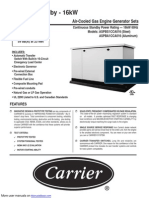SUPERCHARGING
Supercharging of internal combustion engines is in practice for a long time as a method for
improving engine power output. Entering the millennium, a new trend is appearing. The trend
points to small displacement engines in order to meet emission legislation on fuel consumption
and emission control.
The consumers, however, still demand equally the same or better performance they are used to. A
good way to meet these needs is to have supercharging which may be called forced induction. As
already stated, the purpose of supercharging an engine is to raise the density of the air charge,
before it enters the cylinders. Thus, the increased mass of air will be inducted which will then be
compressed in each cylinder. This makes more oxygen available for combustion than the
conventional method of drawing the fresh air charge into the cylinder (naturally aspirated).
Consequently, more air and fuel per cycle will be forced into the cylinder, and this can be
effectively burnt during the combustion process to raise the engine power output to a higher value
than would otherwise be possible.
The points to be noted in supercharging an engine summarized as:
(i) Supercharging increases the power output of the engine. It does not increase the fuel
consumption, per brake kW hour.
(ii) Certain percentage of power is consumed in compressing the air. This power has to be taken
from the engine itself. This will lead to some power loss. However, it is seen that the net power
output will be more than the power output of an engine of the same capacity, without
supercharging.
(iii) The engine should be designed to withstand the higher forces due to supercharging.
(iv) The increased pressure and temperature as a result of supercharging, may lead to detonation,
Therefore the fuel used must have better antiknock characteristics.
In practice, racing car engines use supercharging. The most important areas where supercharging
is of vital importance are :
(i) Marine and automotive engines where weight and space are important.
(ii) Engines working at high altitudes. The power loss due to altitude can be compensated by
supercharging.
THERMODYNAMIC ANALYSIS OF SUPERCHARGED ENGINE CYCLE
The ideal dual-combustion cycle of a mechanically driven supercharged engine is shown in
Fig.3.1. The corresponding cycle for a naturally aspirated engine is shown in Fig.3.2.
� Figure 3.1: Ideal dual-fuel cycle of a supercharged Figure 3.2: Ideal dual-fuel cycle of a naturally aspirated
engine engine
The pressure p1 represents the supercharging pressure and p6 = p7, is the exhaust pressure. Area 9
− 10 − 1 − 11 − 9 represents the work supplied from the engine to the super charger as it is
mechanically driven. The various processes for the supercharged and naturally aspirated engine
are given in Table 3.1.
Table 3.1 Various processes for the supercharged and naturally aspirated Engine
As could be seen from the Figs.3.1 and Fig.3.2 the supercharged engine inducts air at a higher
pressure (p8 = p1) compared to naturally aspirated engine (p7 = p'6 = atmospheric). Hence the
density and thereby the mass of air (m) going into supercharged engine will be higher than the
mass of air going into the naturally aspirated engine (m ). That is to say m > m'.
From the Fig.3.1, it can be noted that the net work output of the supercharged
engine cycle is a function of two positive work and one negative. It
is given by
Wsc = Engine work output (+ve) + Gas exchange work (+ve) − Supercharger work (-ve) (18.2)
= (Area 1 − 2 − 3 − 4 − 5 − 1) + (Area 8 − 1 − 6 − 7 − 8) − (Area 9 − 10 − 11 − 12 − 9)
It is to be noted that positive gas exchange area 8-1-6-7-8 may be greater than the negative area 9
10-11-12-9. It should be noted that there is a loss of work which is not recoverable. Further, it is
to be kept in mind that with increase in supercharging pressure the negative work, will also increase
and therefore there will be a limit for supercharging. The ideal efficiency of the supercharged
engine will decrease with increase in supercharging pressure. However, it is to be understood that
�the net increase in power output is due to increase in mass of charge at condition 1 (Fig.3.1) for
supercharged engine compared to the mass of charge for naturally aspirated engine at conditions
1' (Fig.3.2). The density of charge at 1 is greater than the density of charge at 1' for the same stroke
volume Vs. Further, in naturally aspirated actual engines, there is a negative work due to gas
exhaust process.
It is to be emphasized again that the gain in output of supercharged engine is mainly due to increase
in the mass of air inducted for the same swept volume. The additional mass of air inducted may
also be due to compression of the residual gas volume to higher pressure. The rate of increase of
maximum cylinder pressure is less than the rate of increase of brake mean effective pressure for
supercharged engine. Thus mechanical efficiency of supercharged engine is better than that of a
naturally aspirated engine.
POWER INPUT FOR MECHANICAL DRIVEN SUPERCHARGER
Assuming adiabatic compression of air, the work done on the supercharger per kg of air is given
by
w = − ʃ vdp = h2 − h1
Ƴ−1
𝑝
= CP(T2 − T1) = CpT1 [(𝑝2 )( Ƴ
)
-1]
1
where T1 = initial temperature, p1 = initial pressure p2 = delivery pressure. and, with the
isentropic efficiency of ηc
Ƴ−1
CpT1 𝑝
= [( 2)( Ƴ
)
-1]
η𝑐 𝑝1
where w is the power input to the compressor per unit mass flow rate, ηc is the isentropic efficiency
of the compressor and T1 is the inlet temperature to the compressor. Thus power required to drive
the compressor is given by
Ƴ−1
𝑝 ( )
𝑚̇CpT1[( 2 ) Ƴ −1]
𝑝1
= kW
η𝑐 ×60
where 𝑚̇ is mass of air supplied by supercharger in kg/min and Cp is specific heat of air in kJ/kgK.
This power may be supplied by
(i) A separate drive viz. by a motor or any other prime mover driving the super charger.
(ii) Connecting the supercharger to engine output shaft.
(iii) Exhaust gas driven gas turbine which is called turbocharging .
EFFECTS OF SUPERCHARGING
Before supercharging an engine one should understand its effects. The following are the effects of
supercharging engines. Some of the points refer to CI engines:
1. Higher power output
2. Greater induction of charge mass
3. Better atomization of fuel
4. Better mixing of fuel and air
� 5. Better scavenging of products
6. Better torque characteristic over the whole speed range
7. Quicker acceleration of vehicle
8. More complete and smoother combustion
9. Inferior or poor ignition quality fuel usage
10. Smoother operation and reduction in diesel knock tendency
11. Increased detonation tendency in SI engines
12. Improved cold starting
13. Reduced exhaust smoke
14. Reduced specific fuel consumption, in turbocharging
15. Increased mechanical efficiency
16. Increased thermal stresses
17. Increased heat losses due to increased turbulence
18. Increased gas loading
19. Increased valve overlap period of 60 to 160◦ of crank angle
20. Increased cooling requirements of pistons and valves.
TYPES OF SUPERCHARGERS
Supercharger is a pressure-boosting device which supplies air (or mixture) at a higher pressure. A
centrifugal or axial flow or displacement type compressor is normally used. If the supercharger is
driven by the engine crankshaft, then it is called mechanically driven supercharger. Some
superchargers are driven by a gas turbine, which derives its power from the engine exhaust gases.
Such a supercharger is called turbocharger. There are three types of superchargers
(i) Centrifugal type
(ii) Root’s type
(iii) Vane type
� SCAVENGING IN TWO STROKE ENGINES
In an internal combustion engine, scavenging is the process of replacing the exhaust gas in a
cylinder with the fresh air/fuel mixture (or fresh air, in the case of direct-injection engines) for the
next cycle. If scavenging is incomplete, the remaining exhaust gases can cause improper
combustion for the next cycle, leading to reduced power output.
One of the simplest types of two-stroke engines is shown in Fig. 3.3 In this engine, the charge
(fuel-air mixture in SI engine and air in CI engine) is compressed in the crankcase by the underside
of the piston during the expansion stroke. There are three ports in this engine.
(i) intake port at the crankcase
(ii) transfer port
(iii) exhaust port
Figure 3.3 Crankcase-scavenged two-stroke engine
The compressed charge passes through the transfer port into the engine cylinder flushing the
products of combustion. This process is called scavenging and this type of engines is called the
crankcase-scavenged engines.
As the piston moves down, it first uncovers the exhaust ports, and the cylinder pressure drops to
atmospheric level as the combustion products escape through these ports. Further, downward
motion of the piston uncovers the transfer ports, permitting the slightly compressed mixture or air
(depending upon the type of the engine) in the crankcase to enter the engine cylinder. The top of
the piston and the ports are usually shaped in such a way that the fresh air is directed towards the
�top of the cylinder before flowing towards the exhaust ports. This is for the purpose of scavenging
the upper part of the cylinder of the combustion products and also to minimize the flow of the fresh
fuel-air mixture directly through the exhaust ports. The projection on the piston is called the
deflector. As the piston returns from bottom center, the transfer ports and then the exhaust ports
are closed and compression of the charge begins. Motion of the piston during compression lowers
the pressure in the crankcase so that the fresh mixture or air is drawn into the crankcase through
the inlet reed valve. Ignition and expansion take place in the usual way, and the cycle is repeated.
Due to the flow restriction in the inlet reed valve and the transfer ports the engine gets charged
with less than one cylinder displacement volume.






